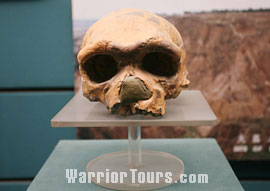Prehistoric Times (1.7 million years ago - 21st century BC)

The Prehistoric Times of China represents the time in human history when there was no formal historical record, from about 1,700,000 years ago to the establishment of the Xia Dynasty in the 21 century BC. This period is also known as the Primitive Society or the Stone Age because then stone tools were the main production tools and they played an important role in people's life. The Stone Age is divided into three periods: the Paleolithic Age, the Mesolithic Age and the Neolithic Age.
Characterized by the use of rudimentary chipped stone tools, the Paleolithic Age or Old Stone Age is the earliest history of human beings. With the Yunnan Yuanmou Man lived 1,700,000 years ago as the representative, Lantian Man and Peking Man also lived during this period. At that time, the uncivilized people were gregarious, living in the caves and living on wild animals, wild fruit, fish and even tree leaves and grass; farming and stockbreeding didn't come into being. During the period, human beings evolved from ape-man to Homo erectus, through Homo sapiens, and then finally formed the shape of the modern man. In addition, people of that time first discovered fire, and learned to use the natural fire in their daily lives, which helped to improve people's physical qualities a lot.
Between the Paleolithic Age and Neolithic Age is the Mesolithic Age. People of that time still lived on hunting and fishing, and clans began to appear. Working more co-operatively in these clans, people invented bows and arrows, fishing spears and nets as well as some hunting tools which made their daily lives much easier. They also invented canoes and techniques for constructing simple houses, and began to domesticate dogs, sheep and pigs.
The last period of the Stone Age, the Neolithic Age is a new starting point in China's ancient economy and culture. Marked by the emergence of farming and stockbreeding, humanity graduated from depending on nature to transforming nature. People began to live a settled life and use grinding stone tools. Meanwhile, the skills of making pottery and spinning were developed, and paintings, characters, sculptures, music and dances all began to appear. Relics of the Neolithic Age are found throughout China, some of which are still intact in villages in such places as Yangshao and Longshan Cultural Areas of the Yellow River watershed and the Hemudu Cultural Area of the Yangtze River watershed.
 During Prehistoric Times, people lived in tribes to enhance their ability to resist natural disasters and terrible weather. The leader of a tribe was usually chosen through the Abdication System. In this the current leader would nominate who he thought was the most capable one in the tribe. He would then be put up for approval by all the members. A legend has it that the Yellow Emperor, Huang Di, lived about 4,000 years ago was the head of the tribal confederation along the Yellow River watershed. He led his people against a clan headed by Yan Di, and then they formed an alliance that became the origin of the Chinese people. Huang Di has been respected as the ancestor of the Chinese nation, and right up to today Chinese people still name themselves as the descendents of Yan Di and Huang Di.
During Prehistoric Times, people lived in tribes to enhance their ability to resist natural disasters and terrible weather. The leader of a tribe was usually chosen through the Abdication System. In this the current leader would nominate who he thought was the most capable one in the tribe. He would then be put up for approval by all the members. A legend has it that the Yellow Emperor, Huang Di, lived about 4,000 years ago was the head of the tribal confederation along the Yellow River watershed. He led his people against a clan headed by Yan Di, and then they formed an alliance that became the origin of the Chinese people. Huang Di has been respected as the ancestor of the Chinese nation, and right up to today Chinese people still name themselves as the descendents of Yan Di and Huang Di.
After Huang Di, Yao and Shun were successively elected as the leaders of the Yellow River watershed. Later, Yu was made as the leader because he made great contributions in controlling the floods. However, Qi, the son of Yu, abolished the Abdication System and replaced it with a Hereditary System, made himself king, and established the first dynasty - the Xia Dynasty in Chinese history. The introduction of the Hereditary System is a clear indicator that the Prehistoric Times of China had ended and China had entered into her Ancient Civilization era.

